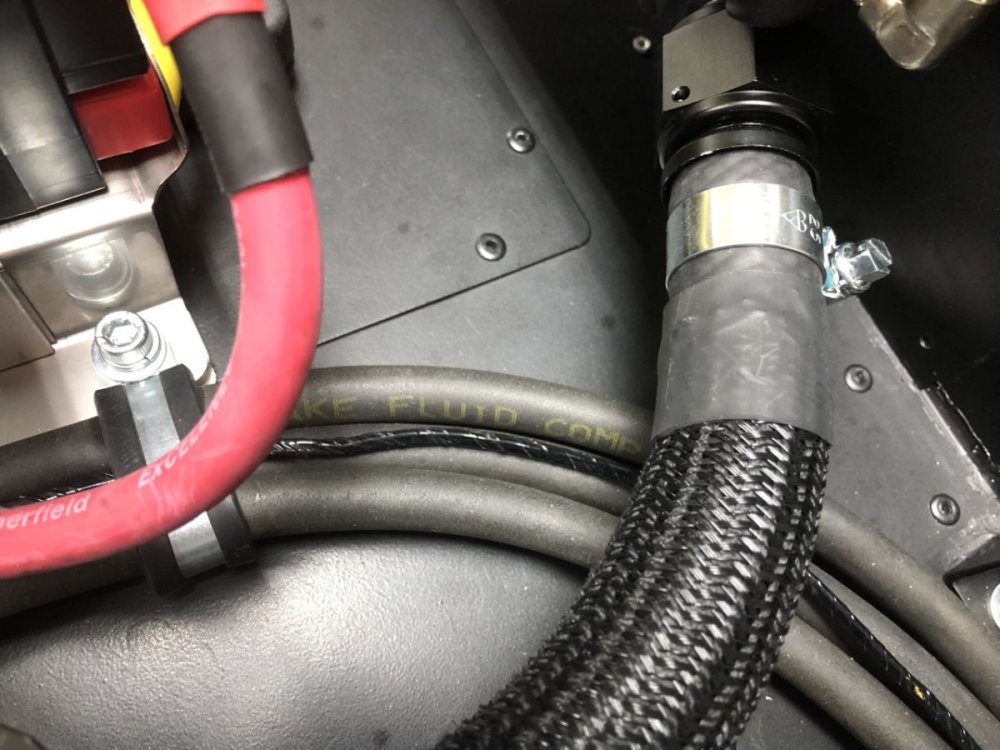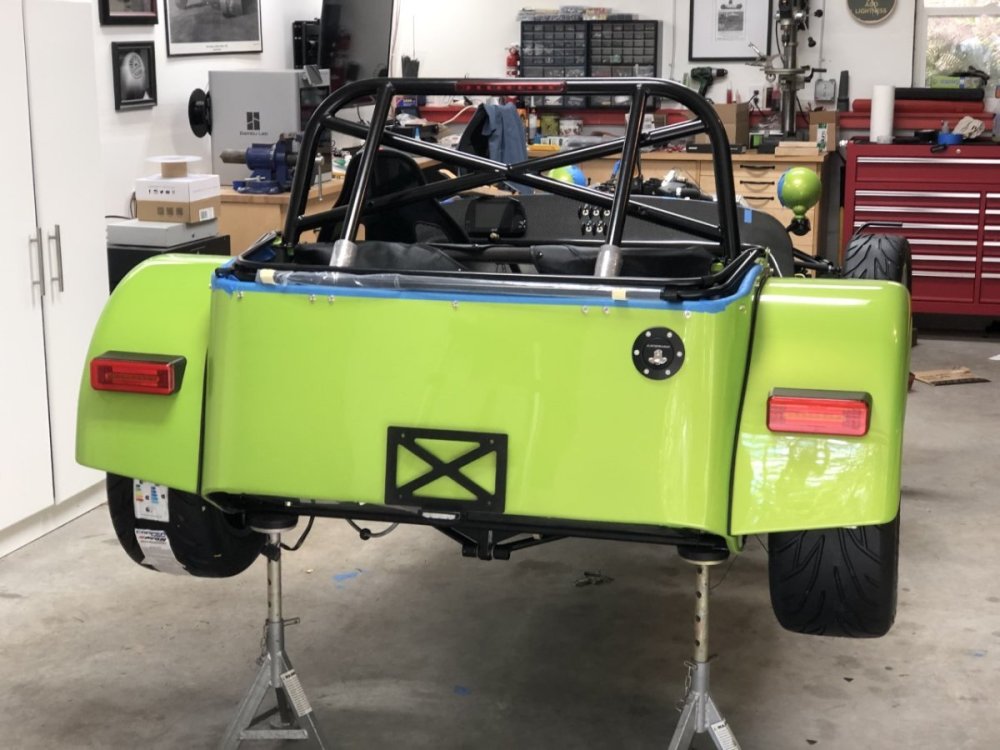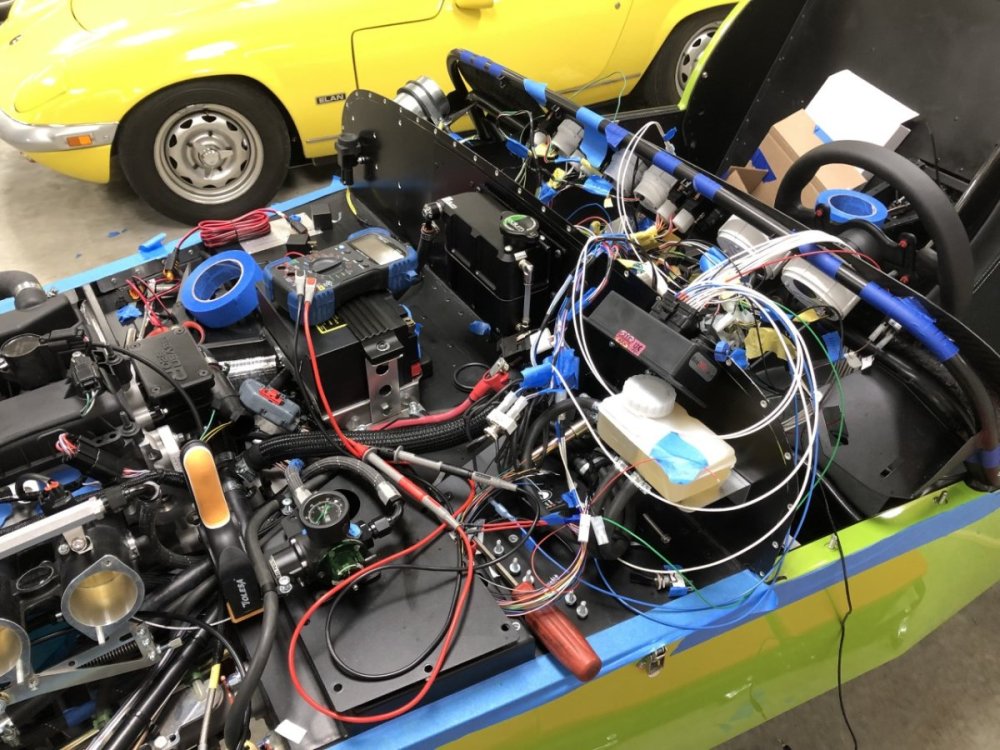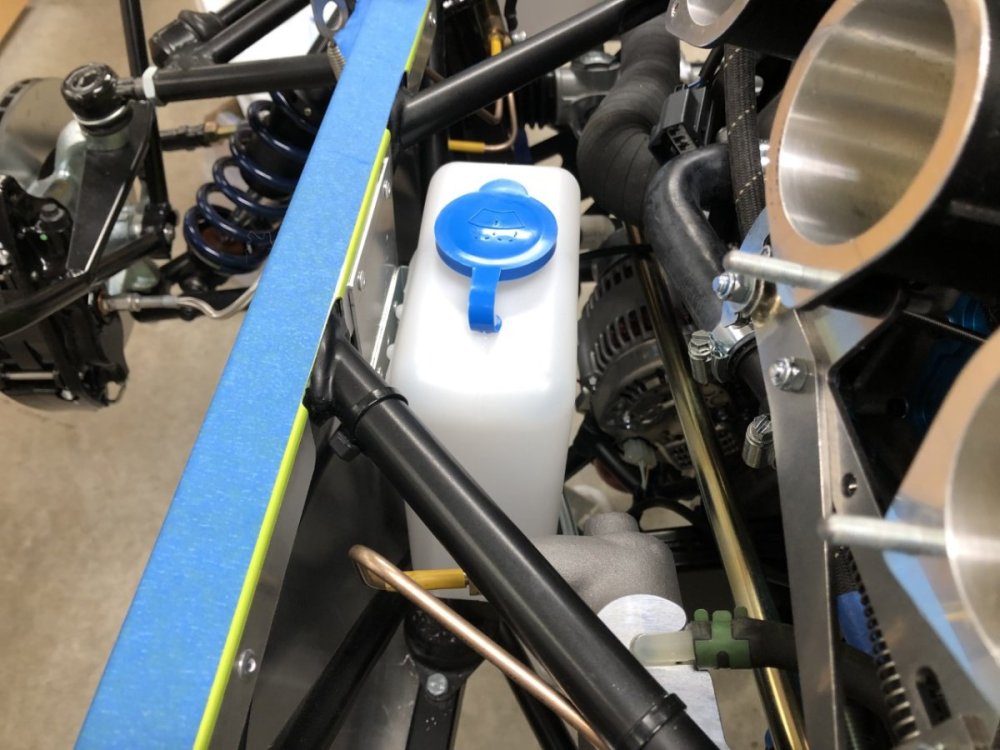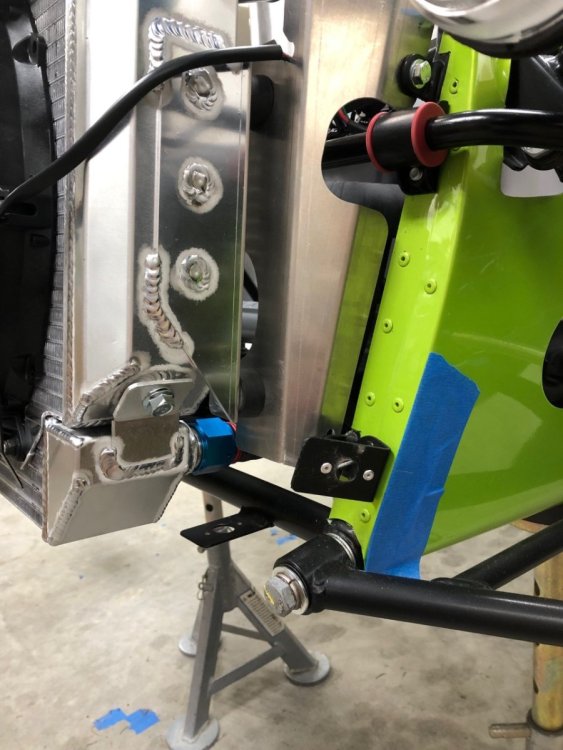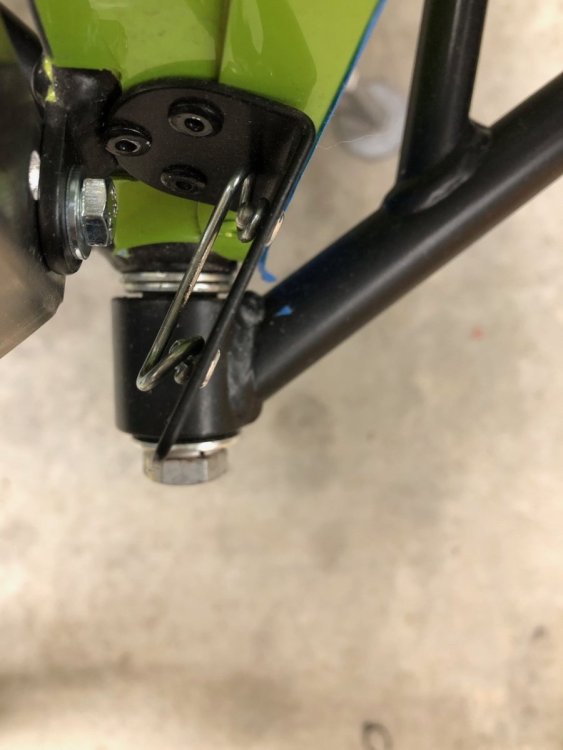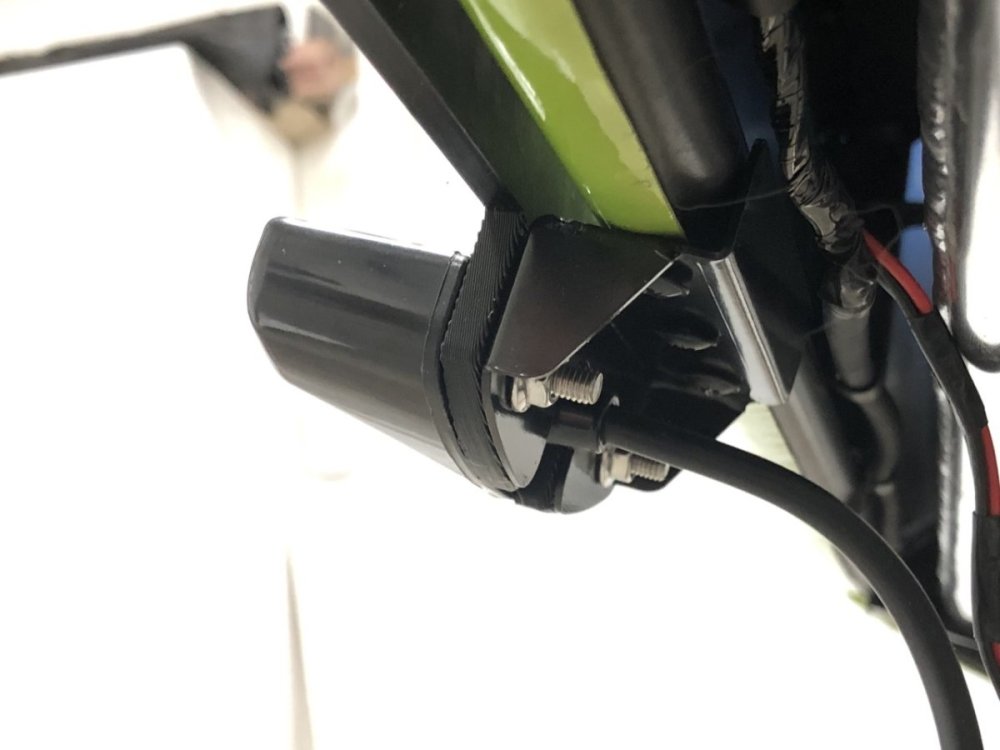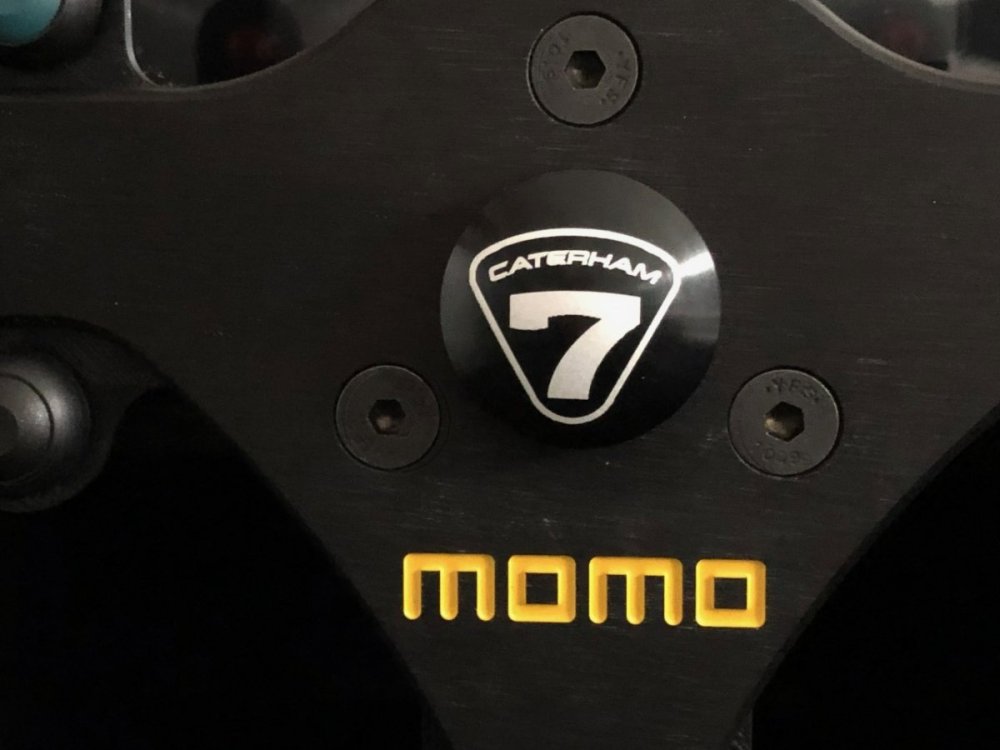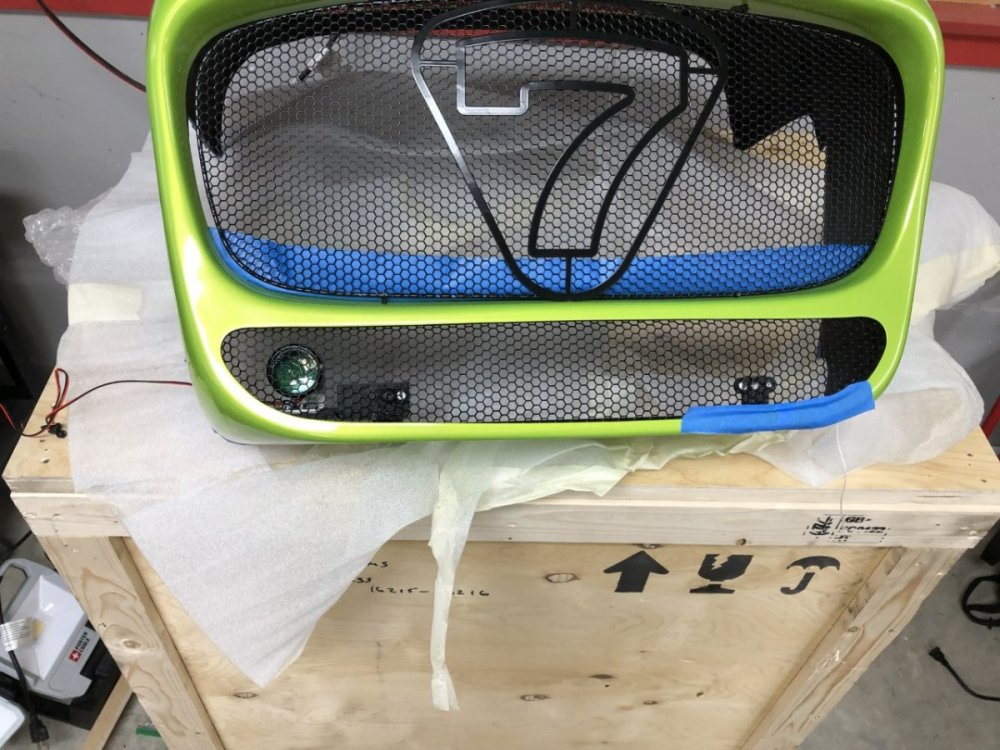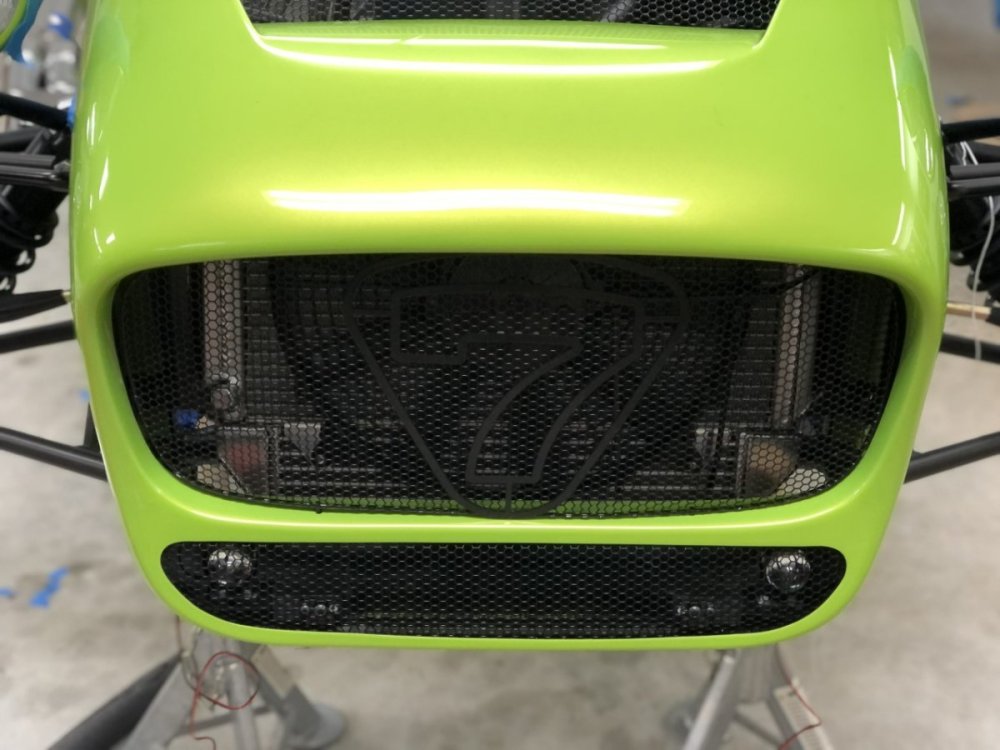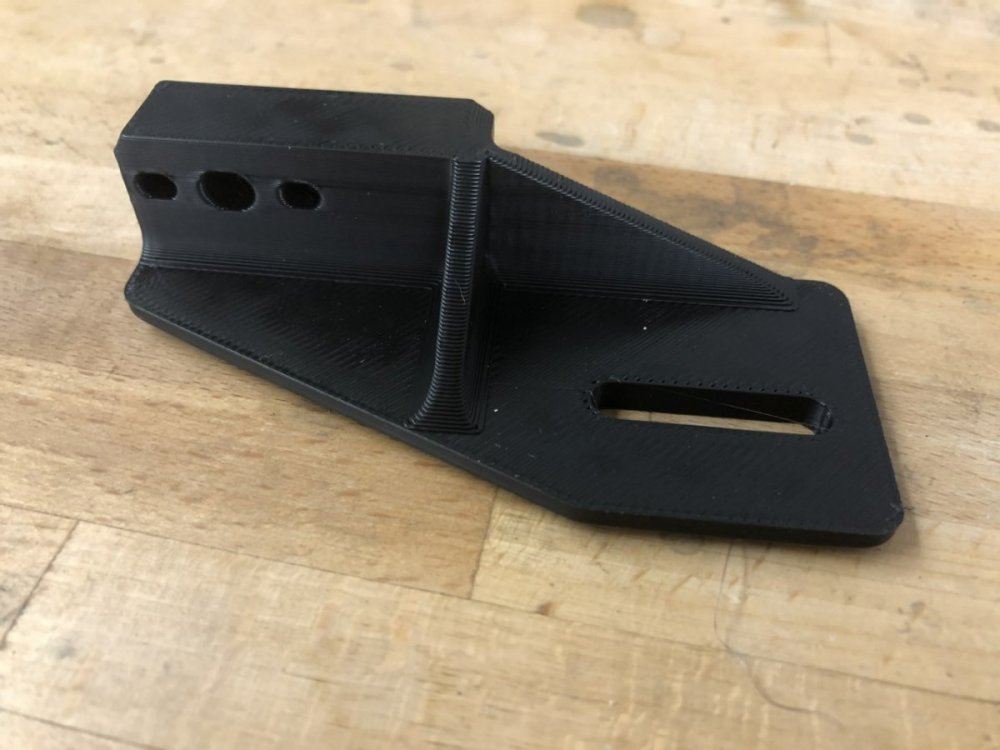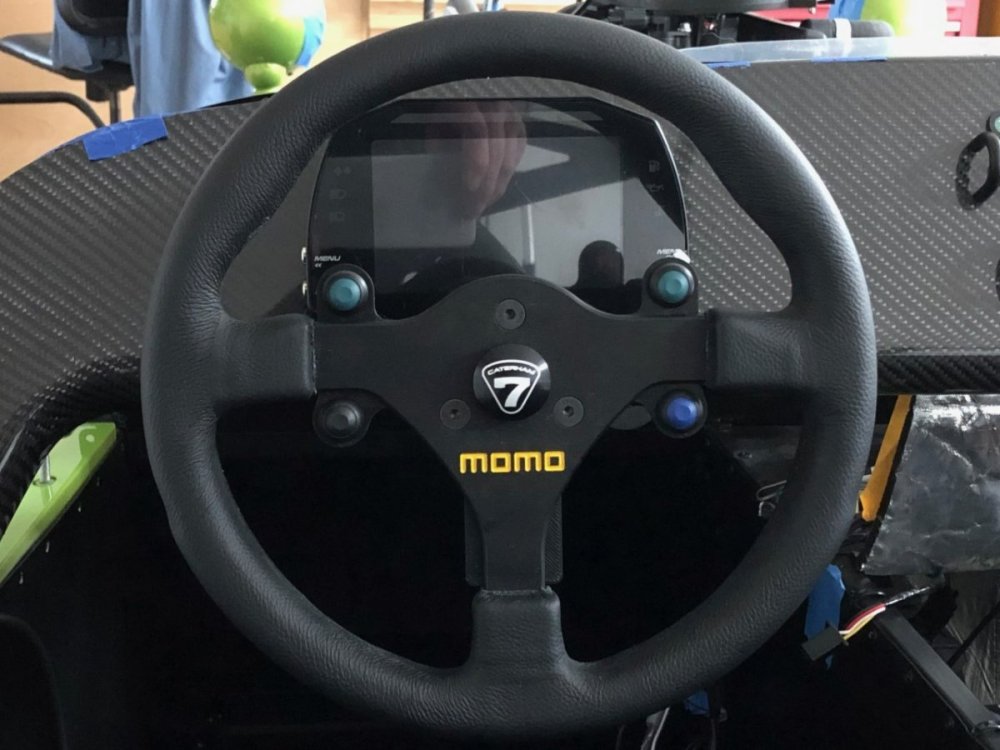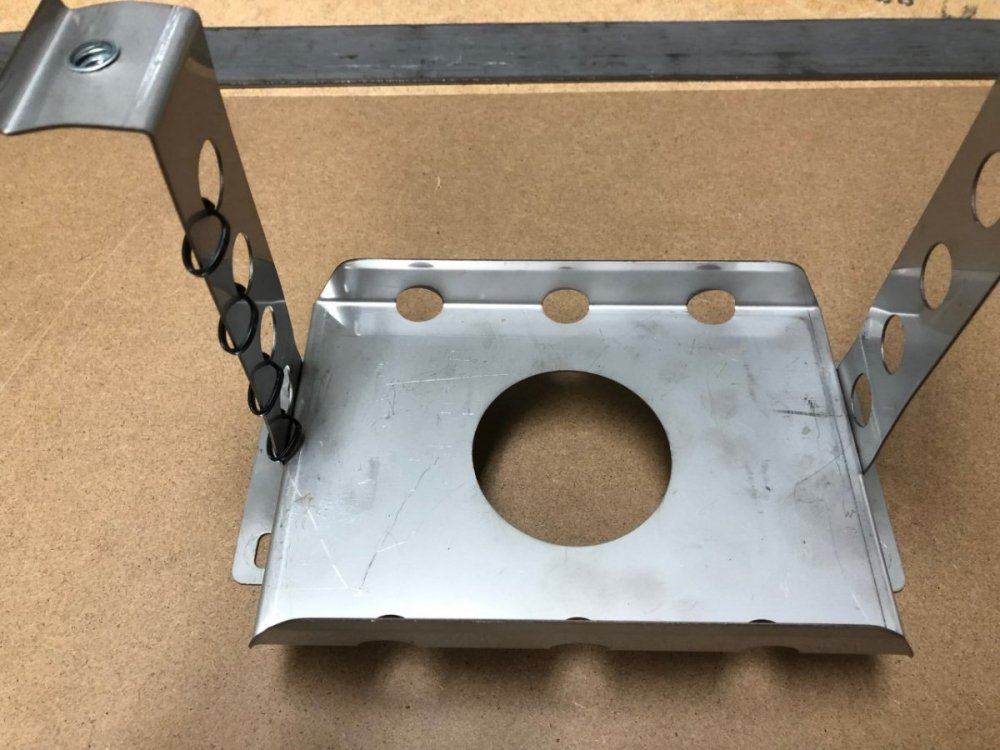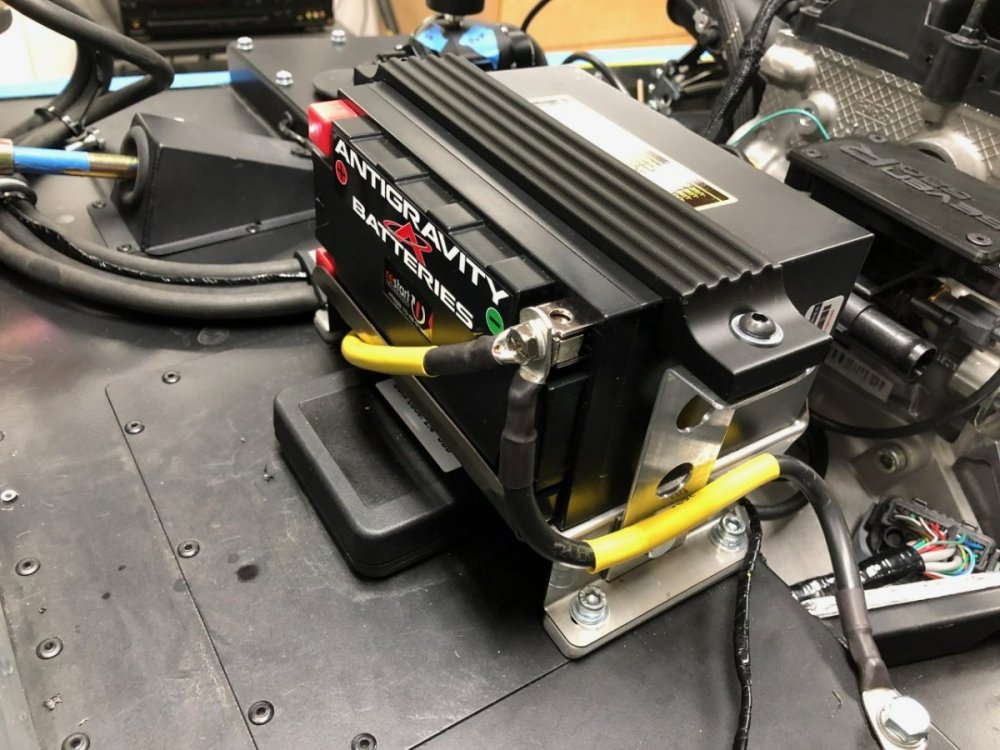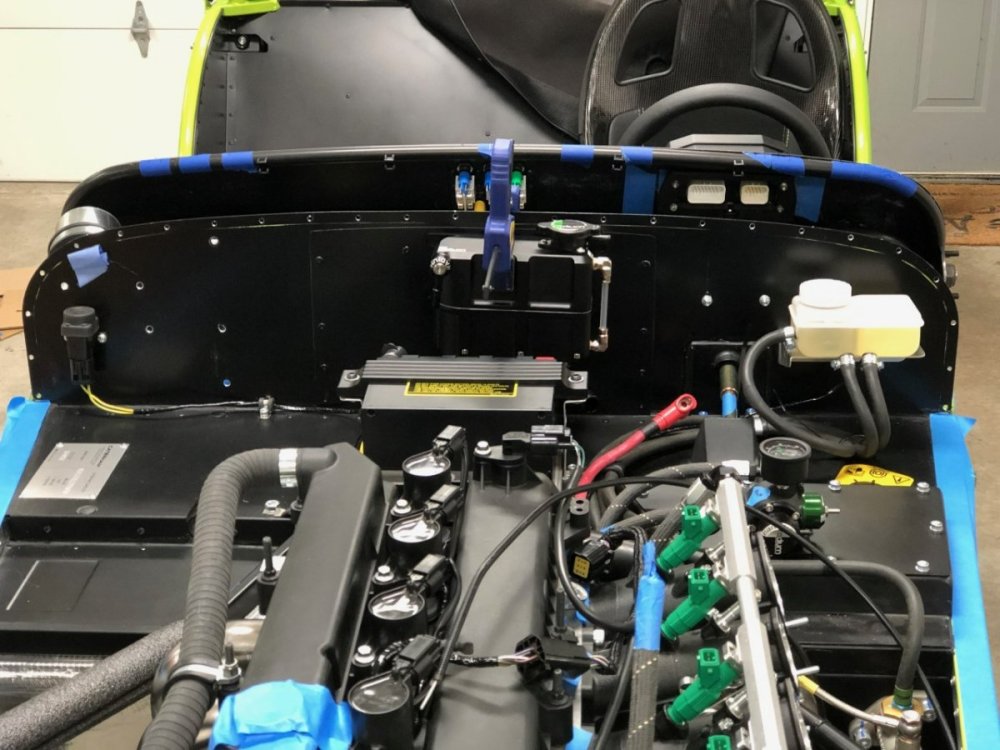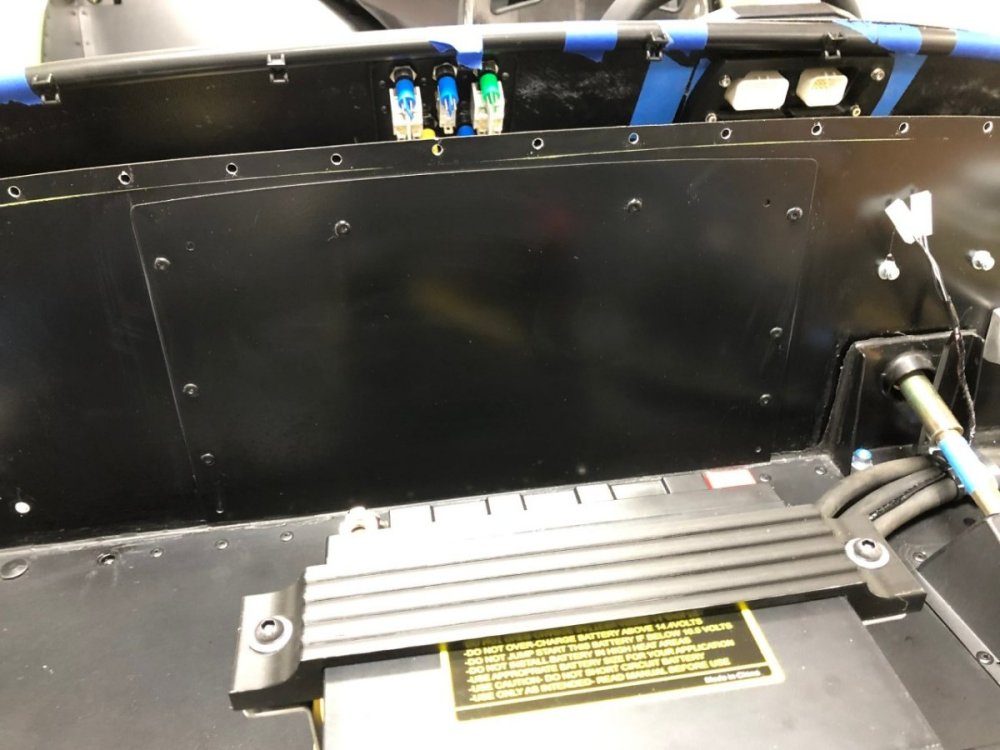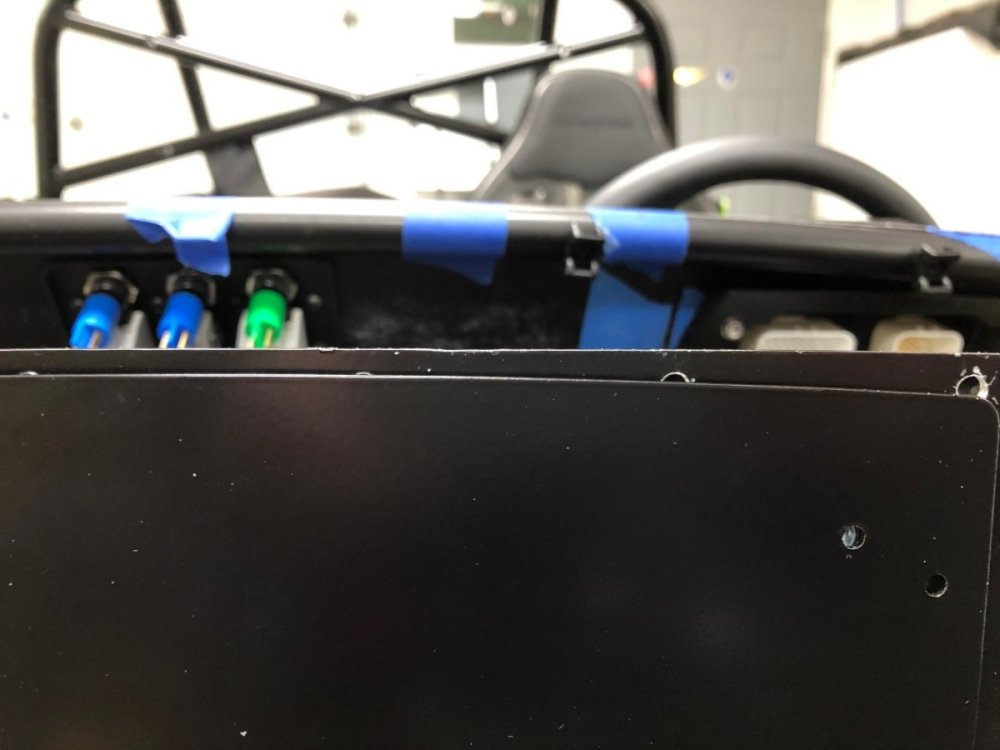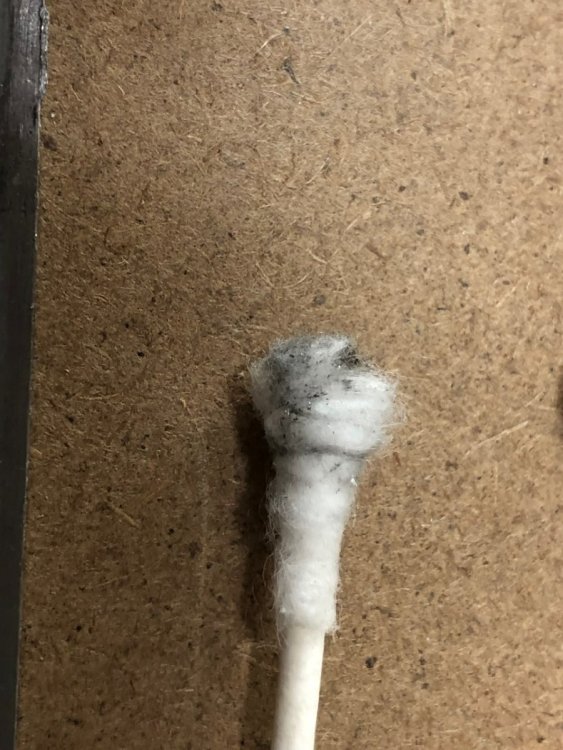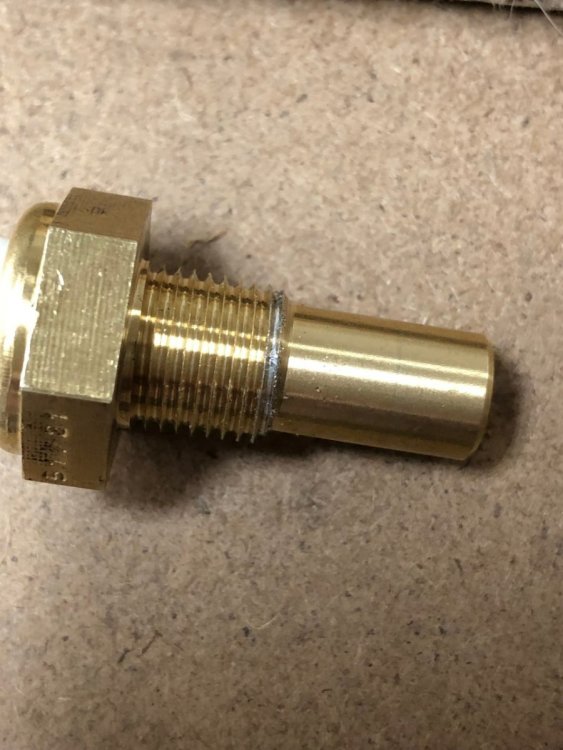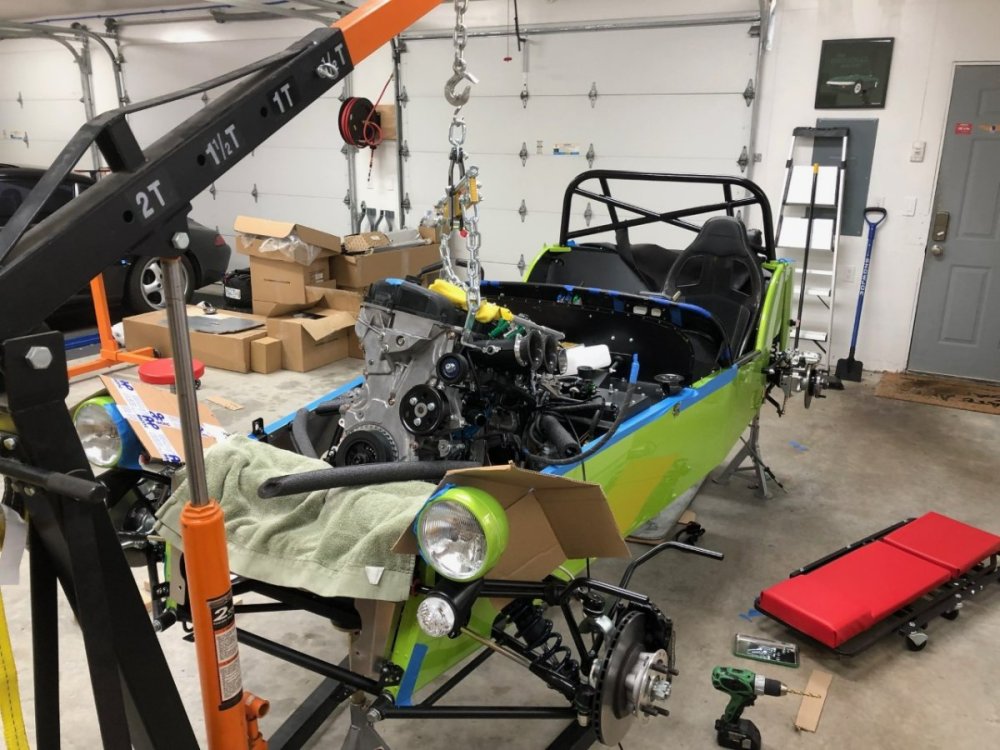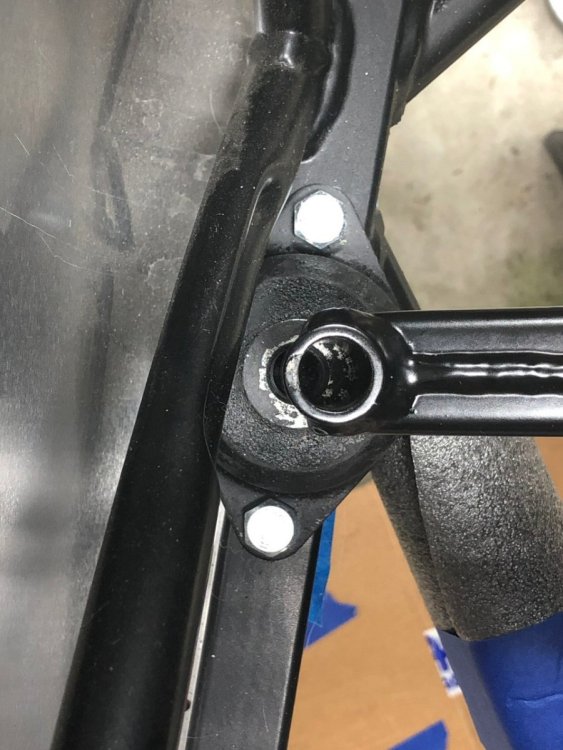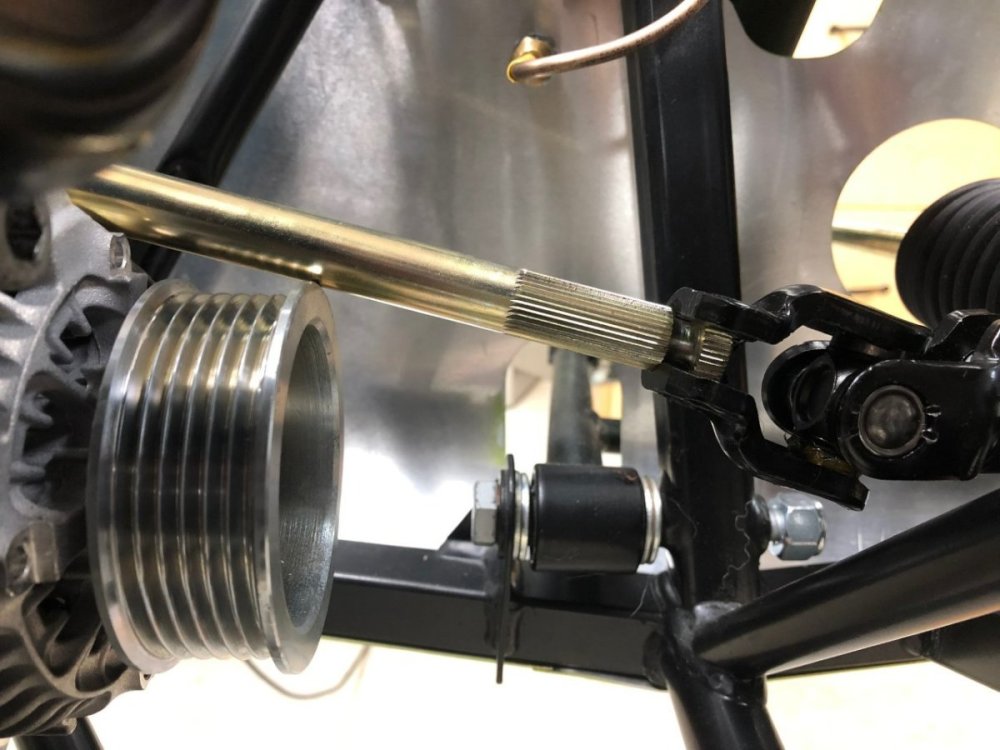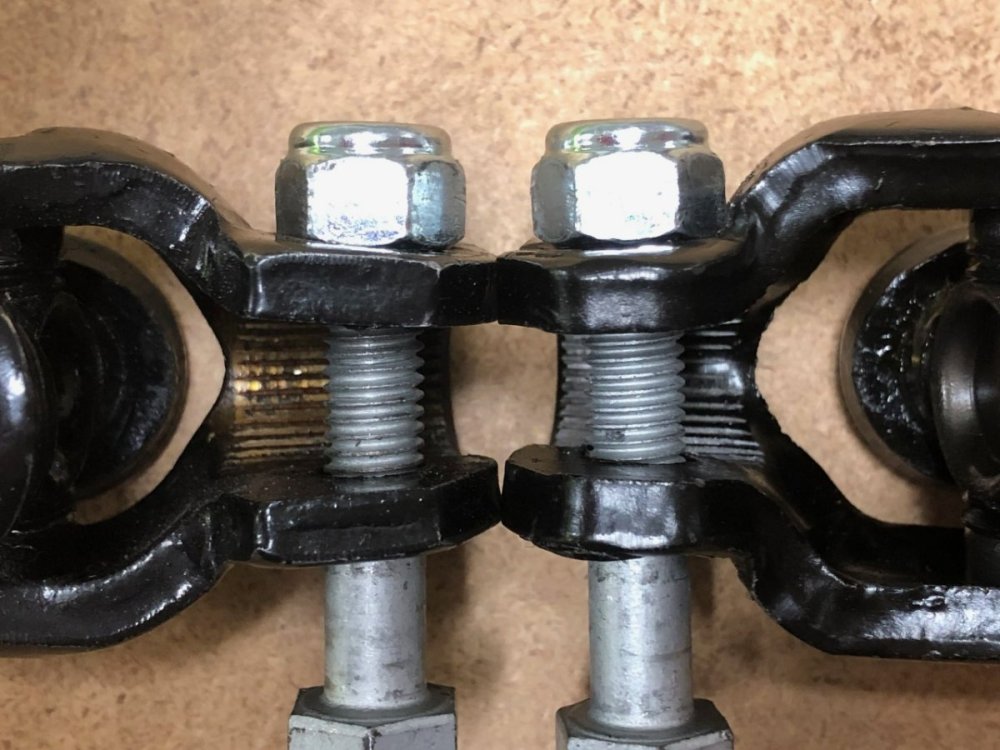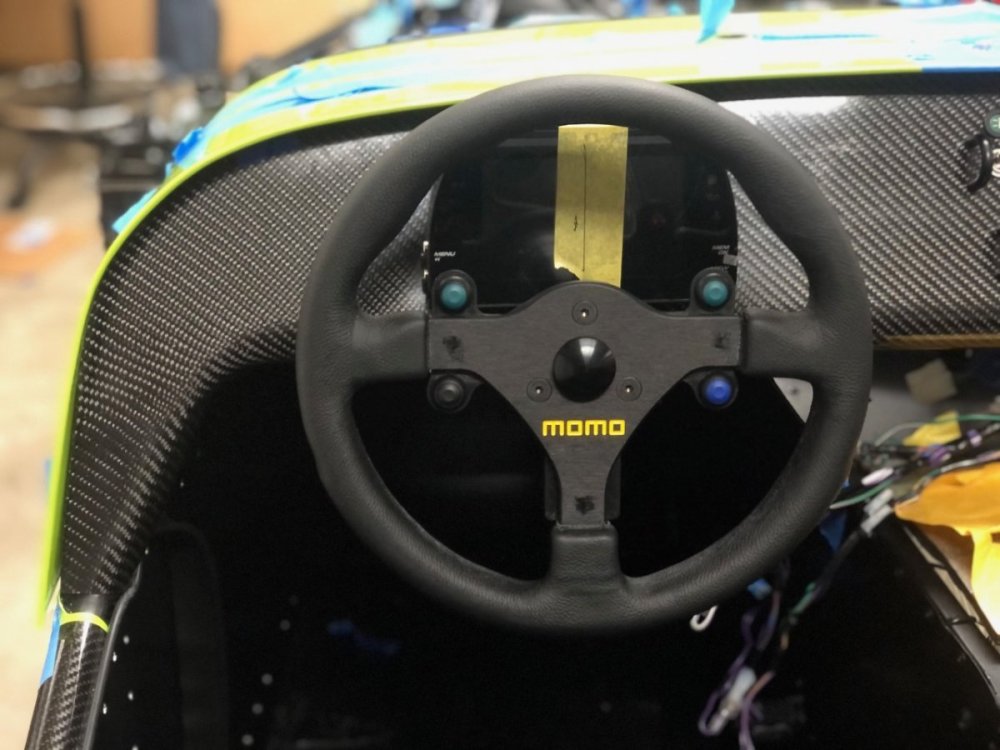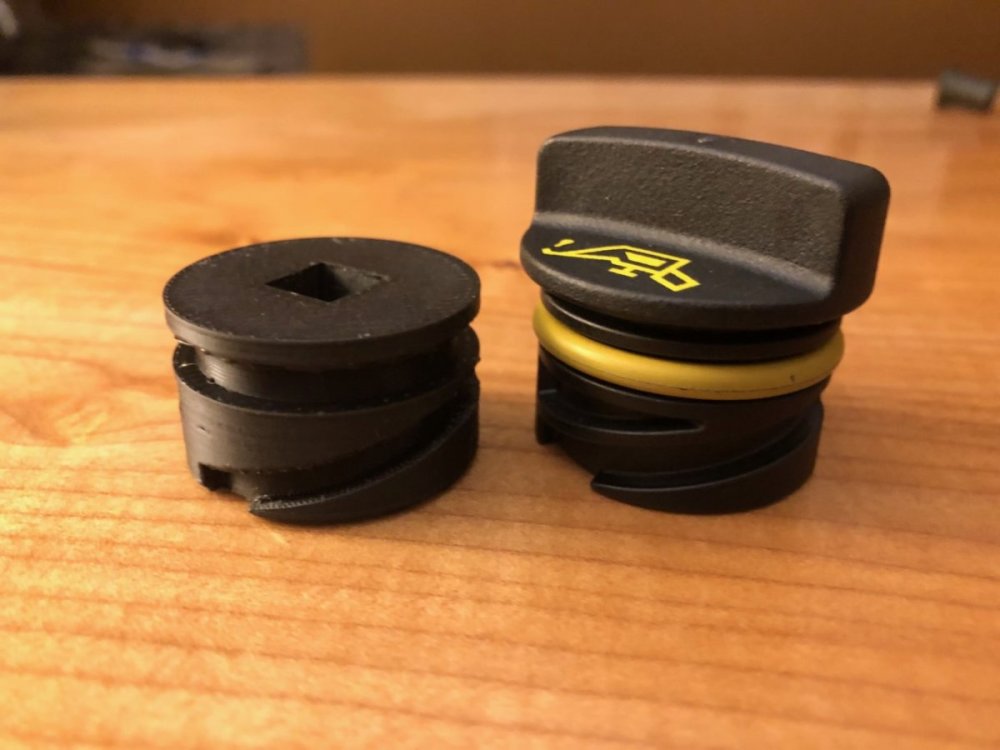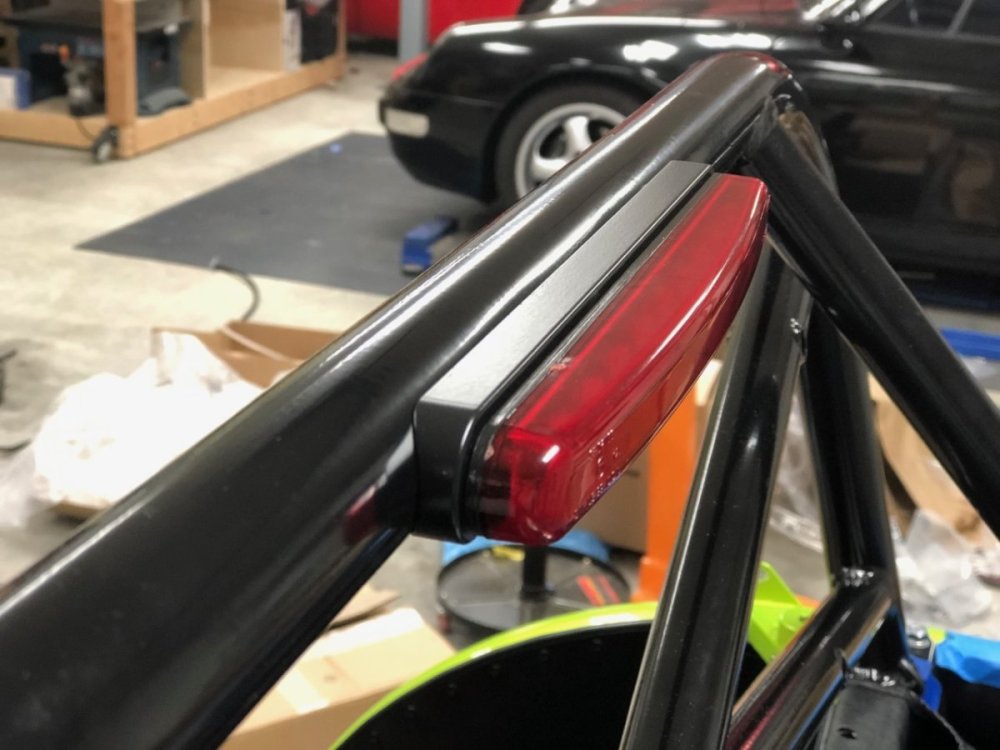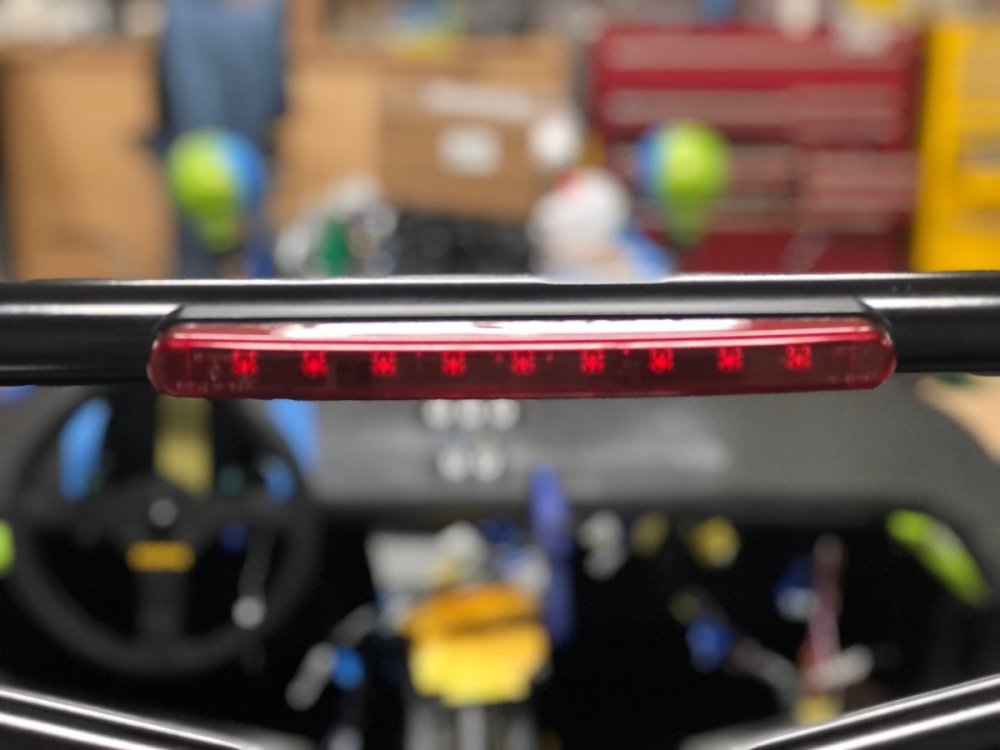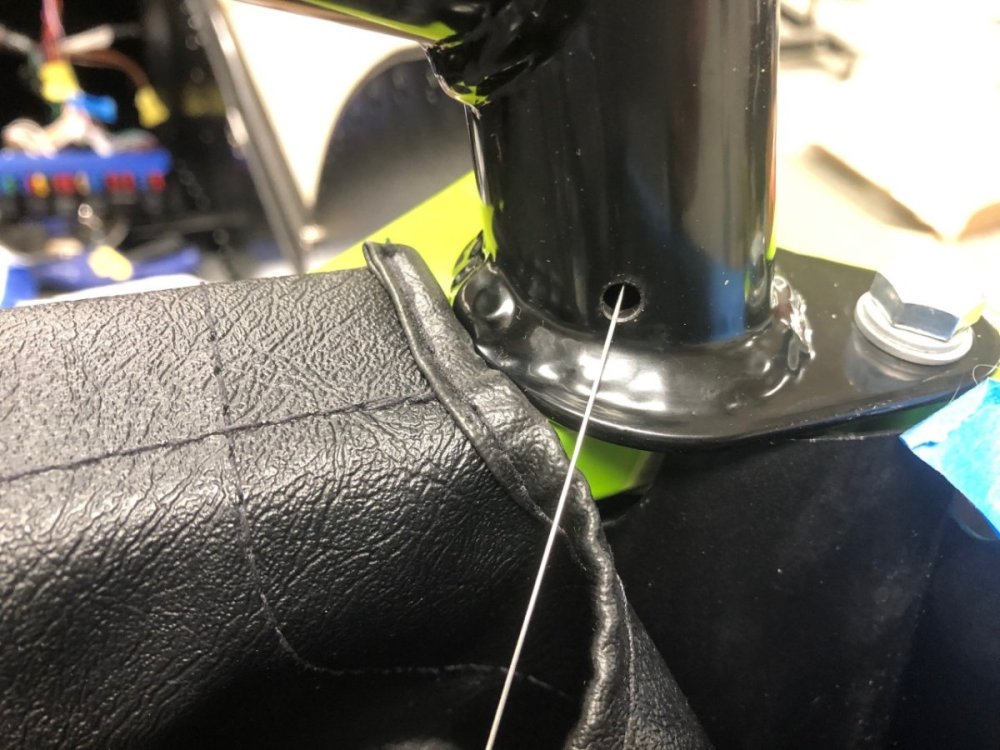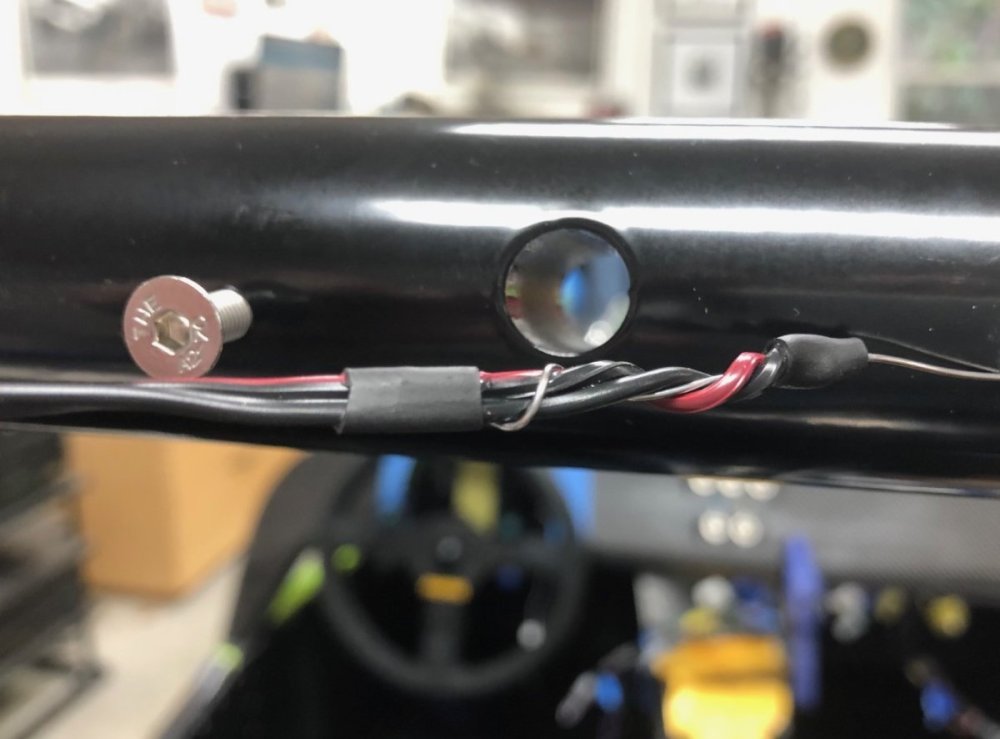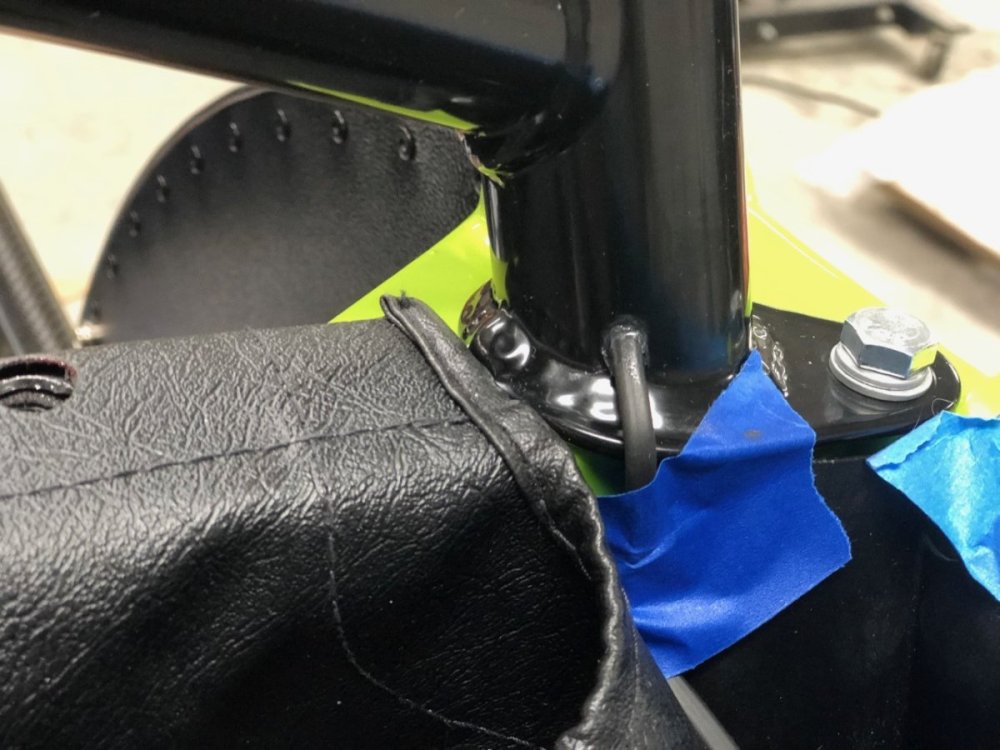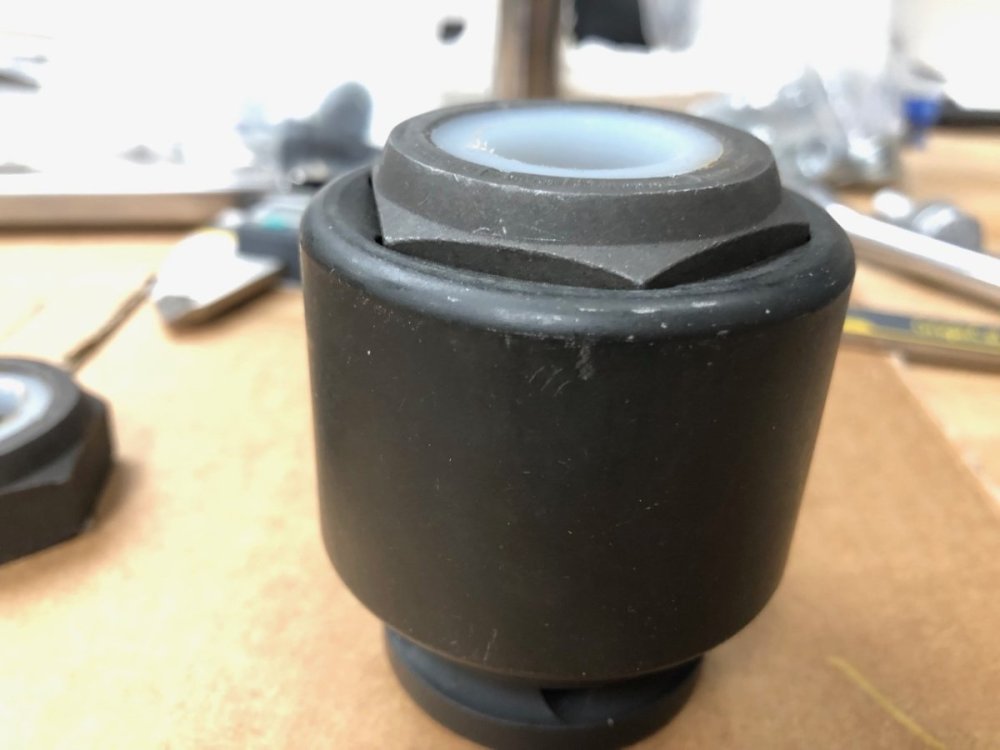-
Posts
3,086 -
Joined
-
Last visited
Content Type
Profiles
Forums
Store
Articles
Gallery
Events
Library
Everything posted by JohnCh
-
-
The underside of the wings have been coated with Herculiner to prevent star cracks. I was initially on the fence about this as the Westfield wings have suffered no such damage since going on in 2004. A closer look, however, revealed Westfield uses much thicker fiberglass. Based on quick measurements, the Caterham wings are about 3mm thick, whereas the Westfield's are over 5mm thick. Undoubtedly heavier, but I suspect this is why I haven't had issues. Rear wings are on, but the driver's side needs to come off to inspect a rivnut that I suspect may be a little loose. Of course it was the last of the 10 fastener I installed on that wing. I'm currently in wiring hell. Despite attempting to order the 620 switch loom since November, I've given up and am repurposing the 420 switch loom. Before making cuts, I decided to reinstall the stock dash with the gauge and switch looms to confirm all those electrical components are working correctly. This way, if an electrical issue crops up for the AiM, Freewheel, or toggle switches, I'll know it's my fault and won't need to test any of Caterham's work. Once an issue with the factory supplied flasher was confirmed, it was time to perform a test install of the Freewheel without cutting the harness. I wanted to wait for that no-going-back moment until I knew the Freewheel worked as expected. Yes, that's a scary picture below, but it was taken after achieving success with the test. I'm now in the process of modifying the switch loom -- wires have been cut! -- and will then tackle the loom for the AiM display. If things go very, very well (they won't) the AiM and Freewheel wiring could be completed this weekend. -John
-
The Radium coolant expansion tank is in and plumbed with a hose covered with nylon braid to provide a little more abrasion protection where it runs into the mass of hoses in front of the battery. I also plumbed the cooling in that area with correctly sized 3/4" hoses. Because I am not using the second coolant temp sensor that feeds the gauge, I don't need the submarine which is 5/8" diameter, and is my guess for why Caterham supplies the smaller hoses (see my rant about this several posts up the page). I ended up using a combination of rubber hoses and Silicone hoses given availability. We'll see how it works. The location for the windscreen wiper reservoir on current cars is in the boot, which is not my preference. Taking up valuable real estate in the small boot to locate a container of liquid does not make a ton of sense to me. To be fair, the factory 420 air box takes up a lot of space, so finding an under-bonnet location means they would need to be creative or use a different form factor, but still… My initial plan was to locate this part on the firewall. However, given I'm running ITBs with a sausage air filter, another option presented itself: under the filter. A simple aluminum bracket to dop it a few inches that repurposes two rivets that hold the side skin to the frame, and it's in place. It does mean I need to remove the air filter to fill it and work round an air horn, but the filter attaches with three 1/4 turn fasteners, and even if I have to remove the air horn (two socket head screws) it's not a big deal to me as I will likely only fill it before a tour when there is a chance of rain. Otherwise, I won't use it and won't bother it keep it filled. The scuttle is now removable to make behind dash repairs/work significantly easier. To minimize the air gap between the firewall and scuttle, low profile M4 rivnuts from McMaster Carr were used. These have a flange thickness of 0.4mm vs. 0.8mm of a standard rivnut. The only challenge was installing the rivnuts that mount to the dash tube and hld the sides of the scuttle in place. On my car -- and it may only be my car -- they drilled the hole for the rivet at an angle pointing rearward rather than forward as needed to place the hole perpendicular to the side of the scuttle. When using a rivet, the hole angle doesn’t matter, but a rivnut is a different story. Given it's a round tube, you can't simply enlarge the hole in one shot and need to walk up on it with increasing larger drill bits. Ok, no picture, but if you look at the photo of the Radium you can see the rivnuts in place. -John
-
Wow, this thread is way out of date. I'll try to post some updates with pictures later. Regarding the airbox, the original plan was to build a cold airbox fed by the 620 nosecone scoop. I eventually gave up on that for two reasons: space and potential AFR issues. Between the dry sump tank and its hoses, the coolant hoses, and the chassis triangulation, there is not a lot of space to snake sufficiently large ducting from the front to the throttle bodies. It's solvable, but it just creates more problems down the road with access. More importantly, I found some flow tests on airboxes that convinced me there was a reasonable chance AFR across the 4 cylinders would be very uneven. A single WBO2 sensor would average out those differences when tuning, meaning some cylinders could be overly rich, or worse, overly lean. It seemed much safer for the engine if I bit the bullet and stuck the filter out the bonnet; nose levels be dammed! Cutting the aluminum scares me but blowing that engine scares me more. That work is still about a month out so I can't tell you how not to do it . I special ordered an ITG sausage filter without the logo and was told to expect arrival in April or May. Based on results from online calculators, the bonnet side vent is sufficient for 420 levels of power. Those same calculators say the 620 shouldn't work, but it clearly does. Perhaps those formulas change with a supercharger, or there is more going on with high pressure in that area that offsets the size of the opening. That said, I also noticed that the opening in the air box itself is smaller than in the bonnet, but again, it seems to work. -John
-
Here are a couple of pictures of a lower 620 nose cone mount. The first shows the location near the lower radiator mount, the second is an overhead shot that highlights the angle in relation to the lower A-arm's front mounting bolt. -John
-
There is a slew of filament types, each with different strength, impact resistance, UV, thermal, and chemical resistance properties. There are even differences between brands for the same filament type. To further complicate matters, some filaments require more specialized printers that can handle the high temperatures required to melt that filament or can heat the bed or the enclosure to specific temperatures or maintain more stable temperatures. Some filaments are also a lot more finicky to print than others, requiring more experience to produce a quality print. This page has an overview of the more common options that might prove interesting. https://www.3dsourced.com/guides/3d-printer-filament/
-
Thanks, I'll keep them in mind if I need to print a file beyond the capabilities of my printer or if I want to try the part as an SLA print.
-
It would never have occurred to me to go down that route, but it looks great. How was your experience with craftcloud? Thanks, John
-
The flex was my original concern, but after testing the initial print, I don't see it as an issue. There is a surprising amount of space for it to flex without touching, and if I stick with this route, I'll print out of carbon fiber nylon which increases rigidity. I'll also add rubber bumpers near the bolts with PPF behind the bumpers just to be safe. -John
-
Here is a close up of the mount taken from under the car looking toward the back. The reverse light bolts go through the plate holder then through the holes on the chassis mount. Easy to replicate something similar from aluminum. -John
-
I'm playing around with something like this that attaches via the reverse light mounting bolts. My 3D printer will only do 10" wide vs. the 12" width of a license plate, but it is wide enough. -John
-
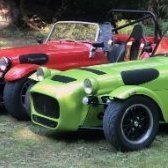
Good Caterham mechanic in Virginia or mid atlantic?
JohnCh replied to Saudio's topic in General Sevens Discussion
Chip Bond at GT Classics in Barboursville has been working on Caterhams for years and has a great reputation, particularly when dealing with the hard stuff. I'm not certain he is still active or if has retired, but his webpage with phone number is still up: http://www.gt-classics.com/ -John -
Next up was progress on the DRLs. The 620 nosecone has a Euro sized license plate bracket glued into the bottom that I repurposed for DRL mounts. Simply drill out the 1/4 turn fastener nuts, bolt on 3D printed brackets, and attach the DRLs. The pic of the 3D printed part shows the final version, which differs slightly from the version used in the other photos (an extra rib and some cosmetic chamfers.) The laser engraving on the horn button is finally done. Other than a smeared E, it looks good. -John
-
The Antigravity Lithium-Ion battery doesn’t fit the factory battery holder, but it seemed a shame to toss the stainless steel base that fits over the ECU. Rebending the rear lip to accommodate the extra length of the AG battery when on its side, then replacing the side straps with shorter aluminum versions and 3D printing a new top clamp, it fits well. I just need to print spacers to fill the gaps between the side straps and the battery. According to the scale, the lithium battery saves over 11 pounds which offsets the weight gain from the bigger engine. BTW this was my first time trying to bend or drill sheet stainless steel. Wow, this is a hard material! About this time, I discovered my kit included the correct number of battery cables: three. Kudos to the QA person for their counting skills! Counting all the way to three can be hard!. Unfortunately, rather than supplying one red positive cable and two black ground cables, my kit came with three ground cables. Apparently counting to three is much easier than differentiating between the colors black and red. Since I am mounting the battery slightly differently than factory, this served as an opportunity to correctly size a new positive cable for my installation. The factory all SS battery holder: The replacement for the smaller battery: -John
-
Firewall cleanup has begun. With no need for the factory airbox, the brake/clutch fluid reservoir was moved to that side, freeing up space to mount the fuse box so it pokes through the firewall, making it easy to change/check fuses and relays. The factory positions this on the back side of the firewall under the scuttle and requires a contortionist to check. In my experience, a fuse is most likely to blow on a rainy night in a dimly lit parking lot. This new position will make those situations far less frustrating. I'll wait to cut the firewall until I finish the under scuttle electrical work to ensure it's optimally positioned. One surprise -- OK, not a surprise, I'm used to looking at aspects of this car and asking no one in particular what the hell the factory was thinking. Anyway, one surprise was the heater block-off plate. The firewall has a large section removed for the heater box. When no heater is optioned, that opening is covered with a block-off plate during the build. There were a couple of problems. First, they size this plate so the top covers a portion of the scuttle rivet holes. Since I am doing a removable scuttle, this is problematic. Second, and the part that made me mutter "Um……" the plate has a number of drilled holes that match up to the mounting holes drilled in the firewall. It makes sense for the factory to reuse the mounting holes, right? Except they drilled the holes in the plate for 1/8" rivets which are juuuust a bit smaller than the firewall holes drilled for M6 bolts. Fortunately, the fix for both issues was cutting 15mm from the bottom, then drilling new holes in the firewall to match the 15mm lower holes on the plate. -John
-
Attempting to install the oil and coolant plumbing was fun due to product quality issues. First, unbeknownst to me (i.e. user error on my part) there are two versions of the rear coolant junction that bolts to the back of the Duratec's head. One has a port for the coolant temp sensor that feeds the ECU and the other has that port blocked off. I purchased the wrong one months ago but didn’t discover this until trying to install the sensor. The replacement arrived, but it had a manufacturing fault that prevented the sensor from seating. The third one was the charm. Turning to the dry sump plumbing, I discovered the oil tank arrived with a poorly threaded 1/8 NPT port for the temp sensor. First the threads were full of aluminum shavings, and second, the sensor blanking plug and sensor could only be screwed in 1/2 turn by hand. Using a wrench to turn the sensor a further 1/2 turn cut a groove in the threads. Bruce Beachman had me bring the tank to his shop so he could run a tap through it, but quickly discovered the tap was actually a little loose. The theory was the first thread had a little damage at the beginning from the factory screwing in the tapered tap too far. My sensor was still a little off when attempting to screw it in after the cleanup, so Bruce switched to a spare which screwed in better. It was still hitting a spot of increased resistance in part of the thread, but it was far less than with my original sensor. With both of those sorted, most of the plumbing was installed. Rather than use the factory coolant expansion tank which mounts under the nosecone where access requires nosecone removal, I'm using a Radium Engineering expansion tank mounted to the firewall. On the positive side, it looks great and is easy to access. The negatives are an additional 1-1/2 lb of weight and a stupidly large price tag. My hope was to finalize the install this weekend, but then I discovered Caterham supplies 3/4" ID hoses for the dry sump breathers but supplies 5/8" ID hoses for the coolant plumbing. This isn't an issue for the 5/8" metal tube they supply which houses the coolant temp sensor for the dash gauge, but it is an issue for the connectors Ford uses on the rear coolant junction and water pump which are both 3/4". Interestingly, Caterham supplies a T-connector to plumb the expansion tank and this too is 3/4". For the heck of it, I lubed up a hose and the T-connector to see how hard it would be to seat, and more importantly, how hard it would be to remove. It took a little effort, but it would seat. Removing it was another story. It was simply not feasible without a hose pick and even then, it was difficult. Not sure I could do this with limited space in the car. More worrying was the outer barb of the T-conne ctor made a cut along the inside of the hose. It was not subtle and didn't give me comfort for longevity. I'll order properly sized hoses this week. -John
-
Progress has been slow thanks to other priorities getting in the way and some level of procrastination born from frustration with the car, some vendors, and a realization that some things I had planned were too much effort to achieve during the initial build. There are, however, a number of updates. I'll break them into a few posts, but don't worry, I promise to sprinkle a little bitching and moaning into each one. The engine and transmission are in. I've removed and replaced the Duratec in the Westfield a few times over the years. I've always done it solo and without a load balancer. It's a pretty straightforward process. Not so with the Caterham. Clearances in this car are extremely tight. The process was made more challenging by the fact the rear suspension and driveshaft were already in place, and I opted not to drain the factory installed oil from the gearbox. I'm not convinced I could have done the job solo without the load balancer. It also took more swearing than I'm used to, but that extra effort certainly helped. After confirming crank and chassis centerlines aligned, the driver's side engine mount had to be shimmed 4mm away from the block. Next hurdle was the alternator getting in the way of the steering shaft. The solution was easy (although someone else had to point it out to me): rotate the steering rack forward to raise the u-joint and steering shaft. I'm not sure if this need is down to more production inaccuracies or if the taller 2.3/2.5L block has the alternator mounting holes in a slightly different location, but my OCD went on overdrive as the top of the rack, which is emblazoned with "Caterham" no longer points straight up. Then was the discovery of a really poor steering u-joint. The welds and design were done in such a way that a socket won't sufficiently grip the head or nut of the pinch bolt to tighten it down, and switching to an open-ended wrench meant tightening could only be done 1/3 of a turn at a time. Additionally, the hole for that bolt was drilled really far from the groove in the shaft. I never clamped it down (see above) so I'm not sure how much meat of the bolt was still in the groove as a safety measure for preventing pull out, but it would have been much less than I've seen with my other cars. Before heading down to the hardware store to pick up a socket head bolt and try again, I checked the spare u-joint for the Elan's steering to see if it has the same ID and spline count. Turns out it's a perfect fit, and although it looks the same as the Caterham part, it is made to much better tolerances. There is no issue using sockets to tighten the hex head bolt and the bolt shaft fits perfectly into the groove. Although that may not make a functional difference, it did inspire more confidence in the part. The Caterham u-joint is now a paperweight. Guess which U-joint came from RD Enterprises and which came from Caterham: -John
-
If you have a Windows machine, right-click on the photo, then select "save image as" then select you preferred location from the next window, rename the file to something more intuitive (the default will be a long string of random numbers and letters), and click save. -John
-
@Rooster18221 please see the following Help Guides on posting and private messaging. They should clarify how to do both, but if not send me a PM and I'll try to clarify. Posting Help Guide Private Messaging Help Guide -John
-

Getting closer to a purchase. More questions.
JohnCh replied to Saudio's topic in General Sevens Discussion
This article from Low Flying explains the issue and one approach to address: https://www.pgmsussex.com/_files/ugd/a3e364_2ffc471a99f8410fb2c7868da09405a5.pdf -John -

So, tell us a little about yourselves
JohnCh replied to slngsht's topic in General Sevens Discussion
I have controller on the Westfield that flashes the third-brake light three times upon initial application. Very, very effective. As I'm sure many of you have experienced, there is always that one idiot who wants to ride your tail at speed so they can get a close look at the funny little car ahead. Prior to installing that controller, I would typically have to tap the brakes 2 or 3 times before the person would get the hint they were too damn close. After installation, I rarely have to tap the brakes more than once. I have a BackOff (first link in MV8's post) ready to go into the Caterham. -John -
I did the following: Blue tape on the rollbar where the mount would go, then put a level on the rollbar, and clamped the mount in place when the level on that part was the same as the rollbar. Marked the holes with a pencil, removed the mount and punched the center of one hole. Drilled that hole (it's for an M5 screw as I recall), and tapped it. Put the mount back on with one screw, used the level again to ensure the other hole was still properly marked with that one side already fixed and repeated the drilling and tapping process for the second screw. Bruce and Caterham sell a sub loom that inserts between the rear light connectors. However, I've have read that a dedicated wire may already be in place for this on current cars. I haven't checked yet as I haven't completed the final wiring which will include a Backoff module that flashes the 3rd brake light a few times on initial brake application. I have something similar on the Westfield; based on experience, it definitely gets people's attention. I need to tie up some things before adding the battery and energizing the system to check the connections and complete that work. I was told this brake light assembly fits with the hood in place but haven't confirmed if that's true. If not, I'll deal with it. I don't anticipate ever using the full hood as I much prefer a halfhood and those can be made to accommodate a light in that area. -John
-
Like on my Westfield, some of the electronics are controlled by switches on the steering wheel. However, unlike the Westfield where these switches are hardwired with a coiled cord running from the steering wheel hub to the back of the dash, for the Caterham I'm using the Freewheel kit which is wireless and has some PDM control. Green buttons are turn signals which self-cancel based on an adjustable timer and pressing them concurrently triggers the hazards. The blue button toggles between high and low beams when the dash mounted headlight switch is on or operates as a flash-to-pass button when that switch is off. The small black button will either be used to control the resettable trip odometer or single wipe functionality. The single wipe function is more interesting but will be seldomly used, whereas the trip odometer is used every time I fill up the tank. With the AiM, you either need to go through a few menus to reset it or install a dedicated shortcut button. Since I want that one push experience, it's either add it to the dash or the wheel. The large black button in the center is the horn. I'm having the Caterham 7 logo laser engraved on it which will make it look more intentional. Although I'm using this same switch on the Westfield, the steering wheel spokes on that car are true black, unlike the very dark gray of the Momo, so the button doesn’t stand out to the same degree. Hopefully the logo makes it visually more interesting. My initial plan was to make the switch holder plate out of aluminum, but I went down the rabbit hole of drawing it in CAD and 3D printing a mockup to visualize it and play with button locations to ensure they are comfortable for me to operate. I then realized 3D printing gives me additional flexibility for wire management as I can print in channels to hold the wires then small cover plates to hide them from view. The final version will be printed with more care and should look good in the carbon fiber nylon used elsewhere on the car. I'll post pictures of the wire management later. Lastly, I played around with making a low-profile oil filler cap. The rough mockup works surprising well. I need to make a very minor tweak then print it with finer resolution settings out of the carbon fiber nylon, but I think this is the direction I'll go. Although I'm not a fan of an oil filler cap that requires a tool, the square shape is sized to fit a 3/8" driver. Since I always carry tools with me, I will always have one of those in the car. I may also print up a small tool that I mount under the bonnet to make it even more convenient. I'll post more updates this weekend after the engine and transmission are in. I've already had a few interesting discoveries with that process. -John
-
A few random updates I'll break into two posts. First, the 3rd-brake light is installed. I purchased an unused Beachman Racing setup from someone on the forum. The mount is beautifully machined from aluminum and is normally installed in its natural state, but having that as the only piece of brightwork on the car seemed a bit out of place. A light sanding, then shooting it with primer followed by Rustoleum Satin Black which is a decent match for the powder coating used by Caterham, and it blends in with the rollbar. Running the wire through the rollbar was not as daunting as it sounds. I ran safety wire, which is thin yet stiff, from the exit hole on the bottom of the rollbar up to the entry hole on the top, grabbed it with a pick, pulled it to the hole, then reached in with forceps to grab the wire and pull it out. Wires from the light were then twisted to the safety wire and sealed together with adhesive lined heatshrink to avoid separation in the middle of the rollbar, and finally the whole affair was pulled through the rollbar. Drill holes were painted to prevent corrosion and the holes were sealed with liquid gasket to prevent water ingress. Worked great. When buttoning up the rear suspension, I discovered an interesting problem with the axle nuts. These are handed with left-hand threads on the driver's side and normal, right-hand threads on the passenger side. The bottom of both nuts were 41mm, but the top of each was larger and required a 42mm socket to engage the full height of the nut. The delta between top and bottom was larger on the driver's-side nut and this difference was visible to the naked eye. Not a problem per se, but I don’t' recall seeing this in the past with any nuts. Once a 42mm socket arrived, they went on without issue. The photo below shows the driver's side nut dropped into a 41mm socket, with the greater than 41mm portion sitting above the surface. -John
-
This morning I heard back from SBD about using a fuel pump with pressure regulator rather than adjusting pressure via PWM control of the pump. I don't have the specifics yet but will share them once I get to this part of the project. Good news is that it sounds simple: "you will just have to move one of the pins in the ECU wiring hood, which is a very simple process on a MBE9A4 ECU, because the pin that controls that the digital pump controller is different to the one you would need to control a relay that can energise the standard pump. You will also need to fit just a standard 30amp relay." -John


